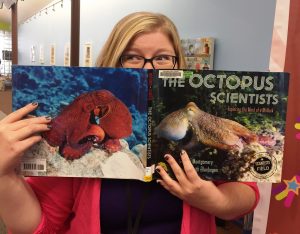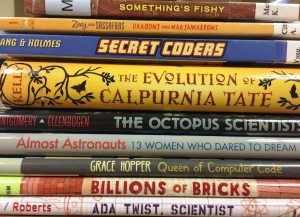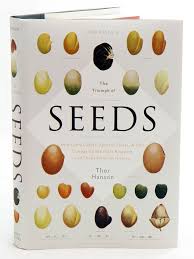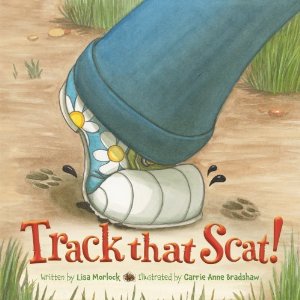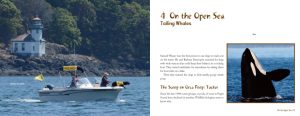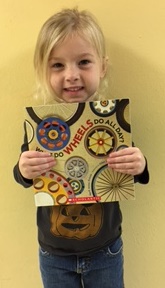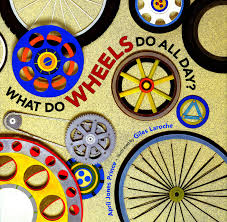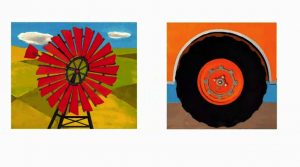Erica Eis, Forest Avenue’s Children’s Librarian is back today to share some great STEM book picks for older readers. With an expertise in literacy and a special interest in STEM, Eis has chosen a few of the best titles to share with you this holiday season. They are all available through the DM Public Library check-out system.
If you’re looking for the perfect gift, Eis suggests considering a STEM book. Find out what the child is passionate about: dinosaurs, space, the ocean. Look for curated lists that are created by librarians, teacher organizations, schools, or universities.
“Whenever a kid tells me she or he can’t find a good STEM book,” says Eis, “I say, ‘Challenge accepted!’ Whatever their interest, there’s a book that fits. STEM books provide an entry to school curriculum and get kids to think critically. If you’re curious about the world, there’s a STEM book for you!”
Grades 3-6
The Octopus Scientists by Sy Montgomery
from Goodreads: With three hearts and blue blood, its gelatinous body unconstrained by jointed limbs or gravity, the octopus seems to be an alien, an inhabitant of another world. It’s baggy, boneless body sprouts eight arms covered with thousands of suckers—suckers that can taste as well as feel. The octopus also has the powers of a superhero: it can shape-shift, change color, squirt ink, pour itself through the tiniest of openings, or jet away through the sea faster than a swimmer can follow…These thinking, feeling creatures can help readers experience and understand our world (and perhaps even life itself) in a new way.
Erica says: “What makes this book interesting is that it features a scientist that studies a particular animal. The author spends time with the scientist. The format of this book introduces young readers to the textbook format, with chapters and picture captions.”
Besides being full of great photos and information, this book helps kids navigate scientific reading.
 The Evolution of Calpurnia Tate by Jacquiline Kelly
The Evolution of Calpurnia Tate by Jacquiline Kelly
from Goodreads: Calpurnia Virginia Tate is eleven years old in 1899 when she wonders why the yellow grasshoppers in her Texas backyard are so much bigger than the green ones. With a little help from her notoriously cantankerous grandfather, an avid naturalist, she figures out that the green grasshoppers are easier to see against the yellow grass, so they are eaten before they can get any larger. As Callie explores the natural world around her, she develops a close relationship with her grandfather, navigates the dangers of living with six brothers, and comes up against just what it means to be a girl at the turn of the century.
Erica says: “This is a great book for those who like Little House and American Girl books. With references to Origin of the Species, this book shows that, even at the turn of the century, girls in STEM can’t be stopped.”
The use of scientific methods and universal themes in this book bridges the gap between Calpurnia’s era and ours.
Almost Astronauts: 13 Women Who Dared to Dream by Tanya Lee Stone
 from Goodreads: What does it take to be an astronaut? Excellence at flying, courage, intelligence, resistance to stress, top physical shape — any checklist would include these. But when America created NASA in 1958, there was another unspoken rule: you had to be a man. Here is the tale of thirteen women who proved that they were not only as tough as the toughest man but also brave enough to challenge the government. They were blocked by prejudice, jealousy, and the scrawled note of one of the most powerful men in Washington. But even though the Mercury 13 women did not make it into space, they did not lose, for their example empowered young women to take their place in the sky, piloting jets and commanding space capsules.
from Goodreads: What does it take to be an astronaut? Excellence at flying, courage, intelligence, resistance to stress, top physical shape — any checklist would include these. But when America created NASA in 1958, there was another unspoken rule: you had to be a man. Here is the tale of thirteen women who proved that they were not only as tough as the toughest man but also brave enough to challenge the government. They were blocked by prejudice, jealousy, and the scrawled note of one of the most powerful men in Washington. But even though the Mercury 13 women did not make it into space, they did not lose, for their example empowered young women to take their place in the sky, piloting jets and commanding space capsules.
Erica says: “With storytelling parallels to the space race, the author pulls from primary sources, interviewing those women who are still alive. In addition, photographs are paired really well with the information.”
This is a great introduction to high school textbooks and use of primary sources. The book contains magazine articles, photos, cartoons, telegrams (left), letters, interviews and more. Yet, it’s interesting enough to pull in younger readers with a high interest in space.
For more great STEM book ideas, check out these lists:

